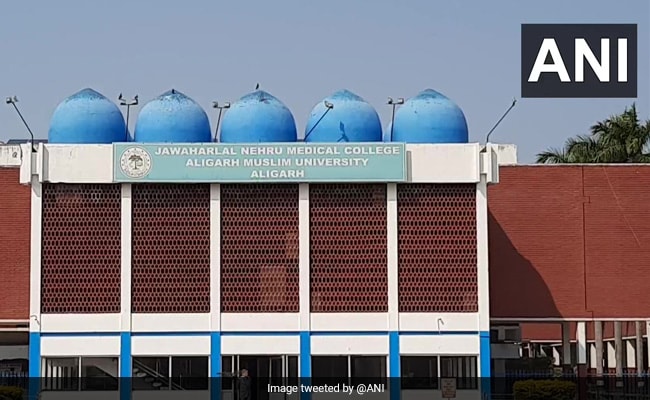2024-02-01 22:53:20

A 7-judge constitution bench headed by CJI D Y Chandrachud reserved its verdict on AMU minority status.
New Delhi:
Grappling with the intractable issue of Aligarh Muslim University’s minority status, the Supreme Court said on Thursday the 1981 amendment to the AMU Act, which effectively accorded it a minority status, only did a “half-hearted job” and not restore to the institution the position it had prior to 1951.
While the AMU Act, 1920 speaks about incorporating a teaching and residential Muslim university in Aligarh, the 1951 amendment does away with compulsory religious instructions for Muslim students at the university.
A seven-judge constitution bench headed by Chief Justice D Y Chandrachud reserved its verdict on the vexed question that has repeatedly tested Parliament’s legislative acumen and judiciary’s prowess in interpreting complex laws involving the institution that was founded in 1875 as Muhammadan Anglo-Oriental College by prominent Muslim community members led by Sir Syed Ahmed Khan. Years later, in 1920, it transformed into a university under the British Raj.
Justice Chandrachud and six other senior judges of the Supreme Court heard heated arguments over eight days before reserving the verdict.
“One thing which is worrying us is that the 1981 amendment does not restore the position as it stood prior to 1951. In other words, the 1981 amendment does a half-hearted job,” Justice Chandrachud said while proceeding to close the arguments.
“I can understand if the 1981 amendment had said… okay, we are going back to the original 1920 statute, confer complete minority character on this (institution),” said the CJI, who headed the bench which also included justices Sanjiv Khanna, Surya Kant, J B Pardiwala, Dipankar Datta, Manoj Misra and Satish Chandra Sharma.
The BJP-led NDA government had refused to accept the 1981 amendment to the AMU Act last week and insisted that the court should go by the five-judge constitution bench verdict in the S Azeez Basha versus Union of India case in 1967. The constitution bench had then held that since AMU was a central university, it cannot be considered a minority institution.
During the arguments on Thursday, the bench said it will have to see what the 1981 amendment did and whether it restored to the institution the status it enjoyed before 1951.
Several top lawyers appeared before the bench to argue for the rival sides.
Those who put forward the view favouring a minority status for the institution, including veteran lawyer Kapil Sibal, contended that the mere fact that only 37 of the 180-member governing council is Muslim does not detract from its credentials as a Muslim minority institution.
Others like Additional Solicitor General Tushar Mehta contended a university getting enormous funds from the Centre and having been declared an institution of national importance cannot claim to belong to a particular religious denomination. They also argued that once the Muhammadan Anglo-Oriental College transformed itself into a university after the 1951 amendment to the AMU Act and began receiving funds from the central government, the institution surrendered its minority character.
A lawyer disfavouring minority status to AMU even claimed it received over Rs 5,000 crore from the central government between 2019 and 2023, nearly the double the University of Delhi, a central university, got.
Some of them even contended that prominent people from the Muslim community who had lobbied with the then British government for establishing the institution as a university wedded to the cause of promoting education among Muslims did not consider themselves as a religious minority in undivided India and advocated a two-nation theory.
Senior advocate Kapil Sibal mounted a spirited counterattack on them, asserting that Article 30 of the Constitution, which deals with the right of religious and linguistic minorities to establish and administer educational institutions, was applicable to AMU.
“Article 30 gives me a right to administer. It does not say that the administration must be in my hands or in Muslim hands or Christian hands. That is not the meaning of Article 30. Right to administer of my choice, I have a choice…,” Mr Sibal said, as he appeared for AMU Old Boys’ Association that pitched for the institution’s minority status.
“Take for example, any minority institution in this country, I don’t think any minority institution in this country is administered by minority. You apply the wrong test, you get the wrong answer,” Mr Sibal argued, while responding to the bench which wondered why the governing council of a minority university be dominated by people belonging to other religious communities.
Notably, the Allahabad High Court had struck down the provision of the 1981 law by which the university was accorded the minority status. Appeals were filed in the top court, including by AMU, against the high court verdict.
The row over AMU’s minority status has been caught in a legal maze for the last several decades.
The top court had on February 12, 2019 referred to a seven-judge bench the contentious issue. A similar reference was also made in 1981.
The Congress-led UPA government at the Centre moved in appeal against the 2006 verdict of the Allahabad High Court that quashed the 1981 amendment to the AMU Act. The university also filed a separate petition against it.
The NDA government spearheaded by the BJP told the Supreme Court in 2016 that it will withdraw the appeal filed by the erstwhile UPA dispensation.
It cited the top court’s 1967 judgement in the Basha case to claim that AMU was not a minority institution since it was a central university funded by the government.
(Except for the headline, this story has not been edited by NDTV staff and is published from a syndicated feed.)
Supreme court,Aligarh Muslim University (AMU),AMU minority status
Source link
8 total views , 1 views today
